There are many cool environmental initiatives on the Island, but in our opinion, one of the most exciting is the MV Pollinator Pathways Project, which is run in collaboration with Biodiversity Works, the Betsy and Jesse Fink Family Foundation, and eight participating Martha’s Vineyard farms.
For those not familiar with Biodiversity Works, it was founded in 2011 by Luanne Johnson. While there are many Vineyard environmental and conservation organizations, Biodiversity Works is the first to be dedicated to monitoring and researching the Island’s rich wildlife. Biodiversity Works partners with other Island conservation groups, along with state and national agencies, community members, students and scientists to look at, think about, and better understand the community of animals we live amongst. They track northern long-eared bats, spotted turtles, snakes, beach nesting birds, otters, willets, kingfishers, swallows and now, bees!
Founder Luanne Johnson explains, “I’d been living and working here [on Martha’s Vineyard] for a long time, working for a lot of Island conservation organizations. I realized the wildlife needed protecting, and I wanted to think more broadly about habitat. Wildlife does not stop at the edge of someone’s yard. Animals certainly don’t think about that. They go where the resources are. So what is happening on an open compost pile, under a birdfeeder is also affecting what happens with the animal population. So we need to think about the whole picture. We work with environmental organizations and with homeowners because conservation land isn’t going to save the biodiversity on the Island.” Luanne continues, “Animals need to be able to move, and we need to all be thinking about the wild land-private land interface.”
Luanne points out that we are pretty lucky here on the Island. We don’t have as many large-scale developments as we see elsewhere — like on the Cape. And, when it comes to nature, the culture of our community here essentially does want to do the right thing. “There are so many organizations and individual advocates,” Luanne says. One of these individuals is Betsy Fink.
For those who do not know Betsy Fink, she is the co-founder of the Betsy and Jesse Fink Family Foundation, which funds projects that move “communities toward a more balanced, sustainable relationship with the environment.” The foundation has done extraordinary work, funding leading food waste projects here on the Island and around the country — from New York to Arizona — and biodiversity efforts from here on the Island to the Arctic. The MV Pollinator Pathways Project is Betsy’s brainchild.
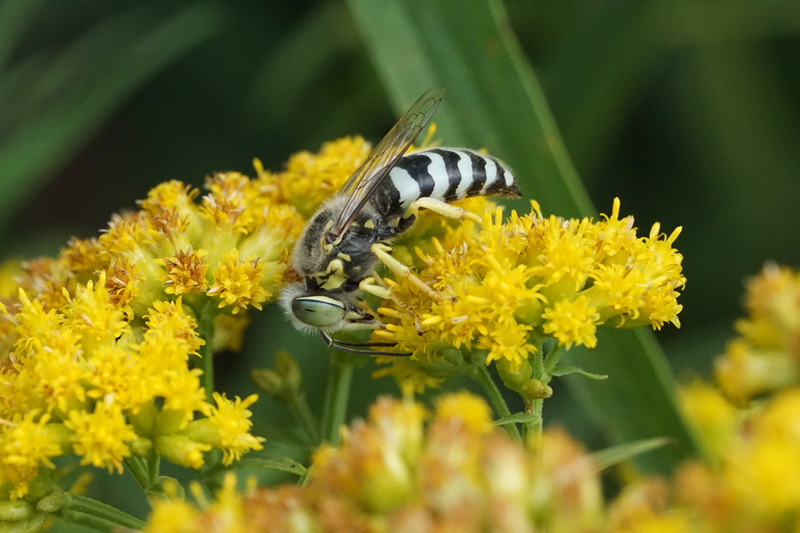
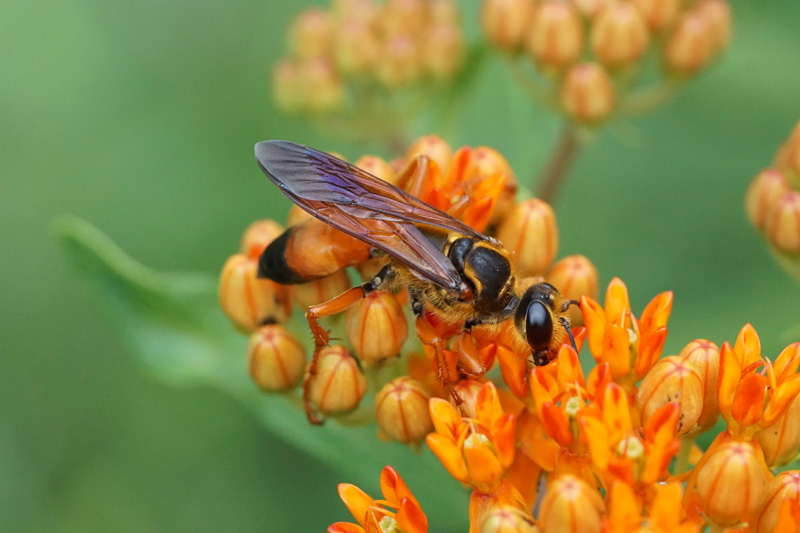
She explains how it all started: “From 2005 to 2016 we owned and operated a 72-acre farm in Wilton, Conn., where we raised livestock and had extensive vegetable production. In addition to cultivating a community around organic foods, healthy eating, and food access and equity, the farm also served as a living laboratory and educational tool for the community. In our fields, we experimented with hedgerows and insectary plantings and saw a direct correlation between supporting pollinators through biodiversity efforts and an increase in yield. These findings, along with our focus on supporting food systems and biodiversity through the Martha’s Vineyard Atlas of Life, led us to think about biodiversity in the context of agricultural lands on Martha’s Vineyard, since they represent a substantial opportunity for biodiversity conservation (roughly 1,000 acres on the Vineyard).”
The Martha’s Vineyard Atlas of Life (MVAL), another collaboration between the Betsy and Jesse Fink Family Foundation and BiodiversityWorks, is an online platform that provides a centralized resource for the public to deepen its knowledge of the Vineyard’s plants and animals. Islanders can also share their observations. The MVAL plays a role in the data collection for the Pollinator Pathways Project on farms, but we will get to this in a moment. For now, back to Betsy.
“In November 2021, our Foundation team made a number of site visits to Island farms and hosted a convening with farmers where we learned that across the board everyone is already engaging with regenerative and biodiversity-sustaining practices, which is amazing, but that ultimately there is a limited ability to devote resources aimed solely at promoting biodiversity. Using feedback from the farm teams as a guide, we considered how we could provide the Island’s agricultural community with technical and financial support for biodiversity initiatives and this led to launching the MV Pollinator Pathways project,” Betsy tells us. “Our Foundation team had been thinking for some time about how to promote and support biodiversity on the Island at scale, specifically through pollinator work with Island-wide linkages. When we made our site visits to farms with Fink Fellow Matt Pelikan, our partner from the Xerces Society, and Molly Jacboson, a pollinator ecologist from the SUNY-ESF’s Restoration Science Center (and also a Fink Fellow), it was incredibly impressive how willing the farms were to consider the management opportunities presented to them, and their brainstorming about how biodiversity-supportive practices could be incorporated into their already heavy workload while still allowing them to meet their bottom line for food production. It was the genuine enthusiasm and open-mindedness of the agricultural community that made farms a natural jumping-off point for the work.”
Beyond being a Fink Fellow, Matt Pelikan is a naturalist and writer who has been involved in conservation on Martha’s Vineyard for 26 years. He has written extensively for local and regional publications about our habitats and spent 12 years surveying Orthoptera (a.k.a. grasshoppers, crickets, and katydids) on Martha’s Vineyard. When Edible sat down with him, he told us, “Farms are an important habitat. And when we were kicking ideas around for what would promote more biodiversity and be a feasible, effective project, we came up with this idea of creating pollination zones on Island farms.”
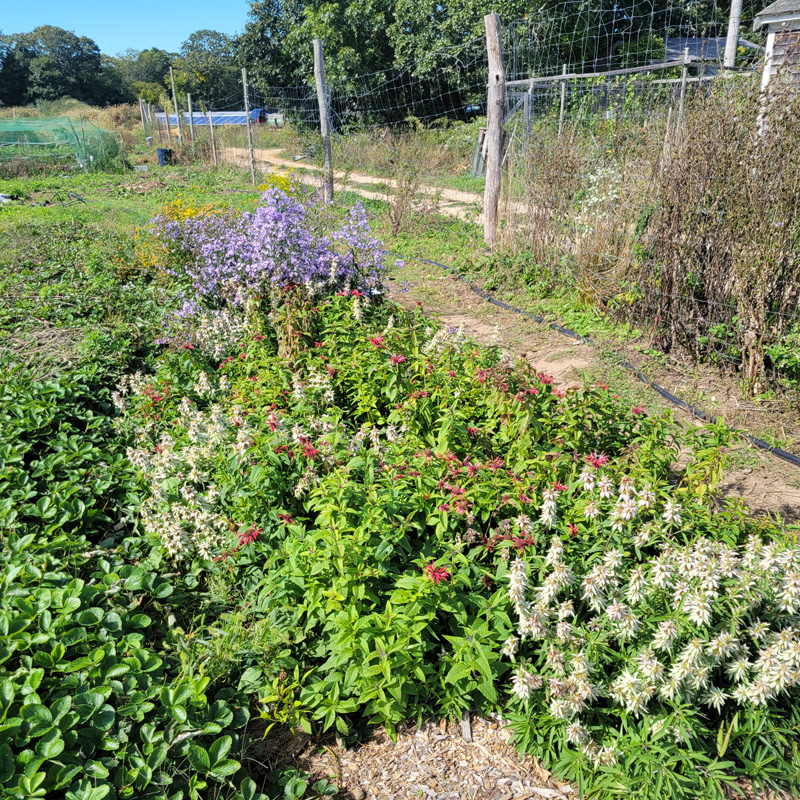
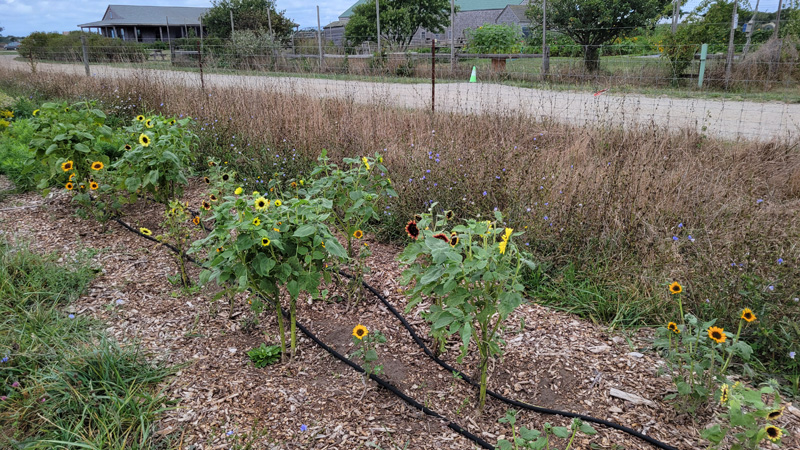
In early 2022, the Fink Foundation approached Island farms about creating small pollinator gardens in and amongst or adjacent to their crops. Beetlebung Farm, North Tabor Farm, Whippoorwill Farm, Mermaid Farm, Morning Glory Farm, the Farm Institute, Thimble Farm, and Slough Farm agreed. Biodiversity Works, with the key help of Elisabeth Sheldon, established and planted the plots, which are roughly 5 x 50 feet at each farm. Elisabeth planted eight or nine species of plants and put wood chips down to discourage weeds. It should also be noted that Elisabeth also maintains the plots for each farm. “We wondered, what if we pick out a small number of plants and see if adding them increases biodiversity. We used one native aster, two native goldenrods, sunflowers, purple and white clover, butterfly weed, and two species of monarda. Of course, variety matters. Sunflowers with double blossoms are of little interest. Single medium sunflowers were a hit,” Matt laughs.
Emily Armstrong, the education director of Island Grown Initiative and participating partner in the project, explains the project in another way.
“The biggest shift for me as a farmer is to think about who I am growing food for. While growing food for humans on these farms, can we also create a space to feed the insects and birds?” Emily loves the pollinator plot at IGI. “It is so beautiful to arrive at the farm and have this area that is blooming and buzzing all summer.”
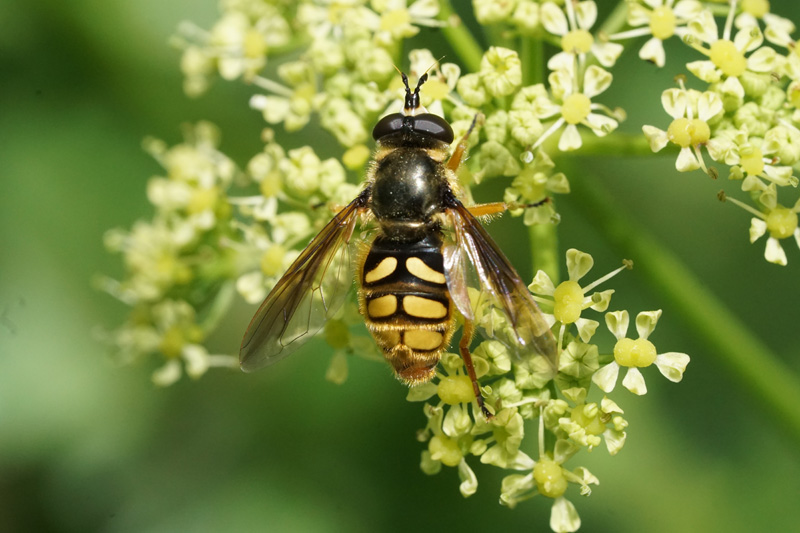
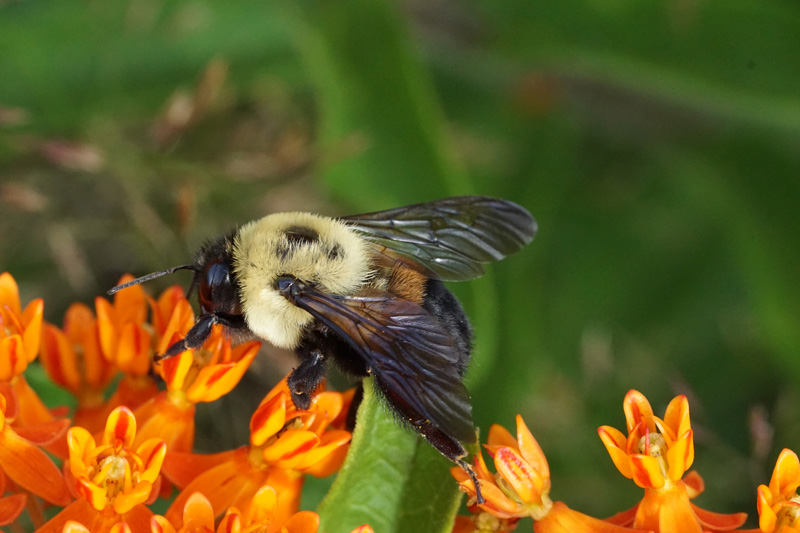
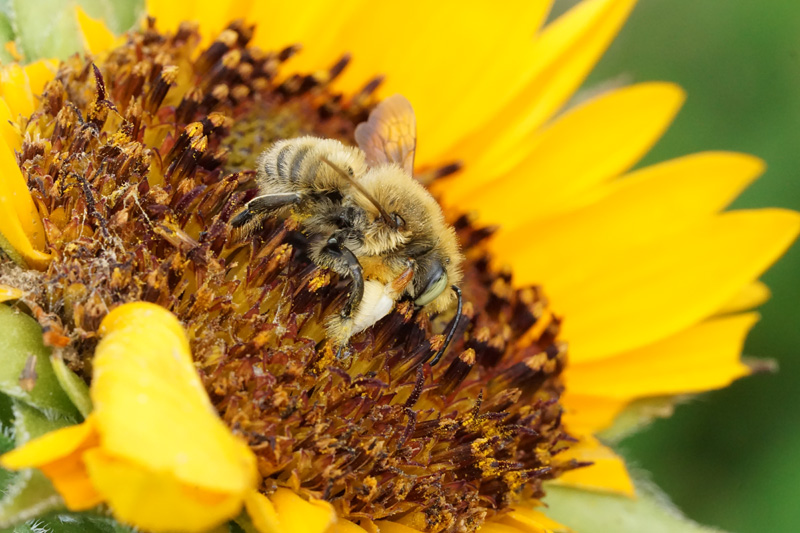
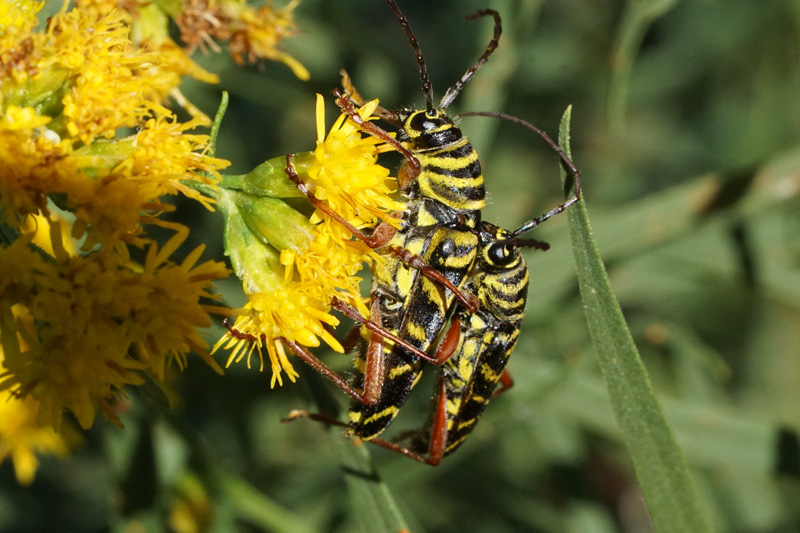
Matt explains that a basic piece of wild bee biology is that bees are “pollen specialists.” “For example, Colletes validus love blueberry pollen, feeding mostly on blueberry flowers. It has an elongated face so that it can reach into the flower,” Matt says, showing us a photo of a pale yellow bee sticking its nose into a blueberry blossom.
“The ecology of bees is fascinating and can be closely tied to human ecology,” Matt continues. “For instance, the squash bee, Peponapis pruinosa, feeds almost exclusively on squash flowers. It apparently started out feeding on native squash species in the Southwest. As those plants were selectively bred and cultivated across more of North America, the bee went with them, and it’s now feeding on pumpkin flowers on Martha’s Vineyard.
“We also knew that honeybees are socially dominant, but I soon learned that they are highly motivated fascists,” Matt says laughing, “and they are highly selective. They want one nectar, one pollen resource. They will suck a patch dry, snarfing up all the good stuff.” Looking ahead, one of the things Matt is thinking about is “Offering something for everyone. A mix of resources. Something for the honeybees and something for other bees so everyone has food and is happy.”
Fair warning, when Matt gets going on the bees, you will be exposed to a hive (sorry, just one bee joke) of incredible photos — “check out the legs on this one,” “look at the eyes here” — and to his passion for the subject. Fortunately, there is a way for all of us to track and learn what he and the farms have found. This is where the Martha’s Vineyard Atlas of Life comes in.
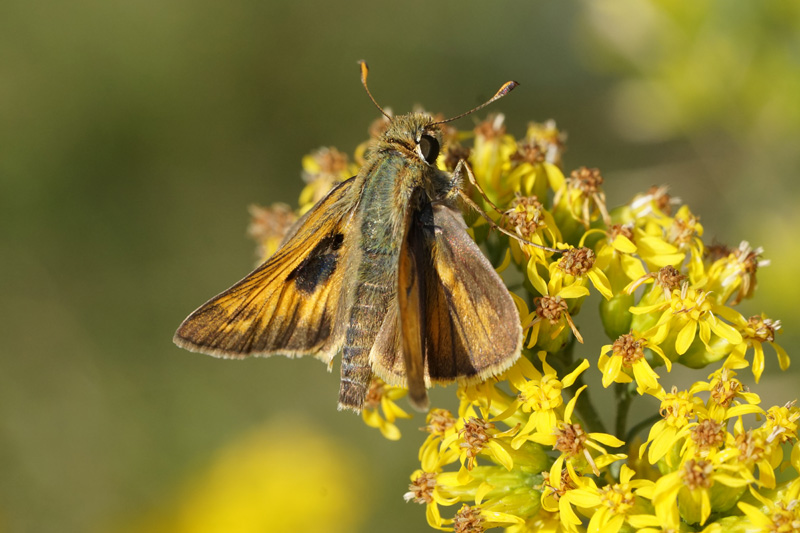
MVAL uses the INaturalist platform to help Matt, and anyone else observing life in the pollinator plots, to upload and catalog their findings. “INaturalist is a joint initiative between the California Academy of Sciences and National Geographic Society,” Luanne tells us. “We use it for a variety of projects. It’s incredible. It harnesses artificial intelligence combined with really strong naturalists who are identifying and contributing to the app to identify species. The more that is contributed to the app, the more the app learns. Sure, anyone could take a pic of a flower or butterfly and could use Google Search and get a visual id, but the photo might be mislabeled on Google. With INaturalist, what you get is more accurate. What is even cooler about it is that it is global. You see flowering patterns, pinch points for road kill. I use it every day.”
“Experts are reviewing the photographs as well,” Matt adds. “So if the artificial intelligence botches the identification, it will be corrected. Essentially, it is like crowdsourcing for nature.” To become an INaturalist contributor, you just need a smartphone. After that it is pretty easy. You take a picture of the subject and upload it. “There are varying degrees of data quality,” Matt says “Two people then must agree on the identity of the subject,” which, according to Matt, makes the data “research grade.”
One of the many cool features of the INaturalist app is that the data can be visualized. In other words, you can select for the MV Pollinator Pathways Project plots and get a map of what has been spotted and identified on each farm in the last year.
When reflecting on the first year with the MV Pollinator Pathways Project, Matt says, “We were pleasantly surprised by the sheer number of bee species found in the pollinator plots. We identified about 35 species. There are roughly 192 species on the Island, and we have added another half dozen species so far this year. Some we missed — in any given year you miss certain things. I’m sure we will find new ones next year.”
In the first year, “some farms produced more observations than other farms,” Matt says, “Habitat accounted for a lot of this. The pollinator plot at the Farm Institute was in the middle of a field, whereas Mermaid Farm’s area was closer to woodlands and a wetland. Because Mermaid Farm’s land was more inherently diverse, we saw a greater diversity of bees.”

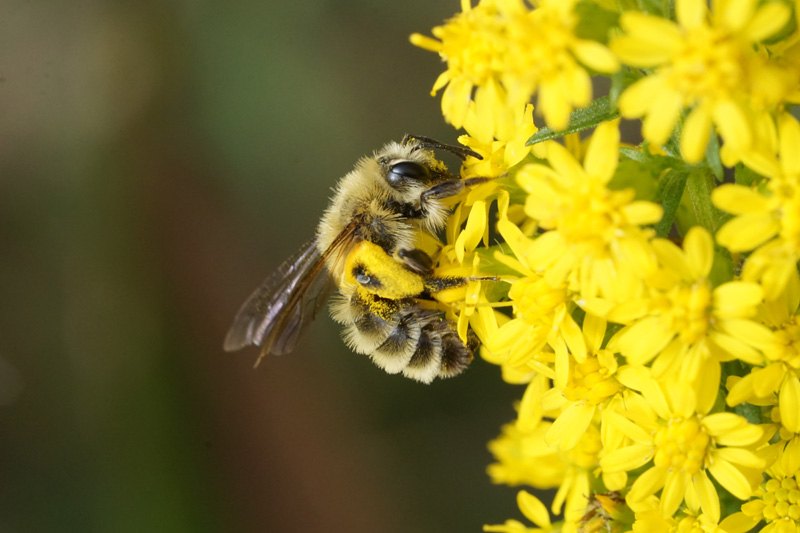
Betsy expands on this thought, “Matt shared insights about how the diversity of surrounding habitat is connected to the success, or lack thereof, of our project plots on the farms. Regardless of our efforts to attract various species of pollinators through our plantings, if the plots exist in a place where there is already little in the way of bee habitat or food nearby, it doesn’t matter how many plants we have there to attract them; it is difficult for them to find the plot and they are not going to thrive. This underscores the importance of planning for biodiversity across a landscape. I look forward to seeing how the richness of the data being collected improves as our plantings mature in the project plots. With this rich data we hope that farms, homeowners, and municipalities see the benefit of the types of plantings we have done to expand the network of pollinators across the Island.”
“I was surprised by the bee fauna at each farm. The distribution of bees was complex,” Matt says. “Each farm had such a distinctive mix of bee species. We found an abundance of metallic sweat bees at North Tabor, but none at Beetlebung, which is just a short distance away. In the next year, I am interested in thinking more about landscape context and a bee’s ecological requirements. For example metallic sweat bees nest in rotted wood. North Tabor has an unmanaged woodland nearby, whereas Beetlebung does not. Is this nesting availability why we see more metallic sweat bees at North Tabor Farm and not at Beetlebung? I want to analyze things as much as I can. Why this set of species here and not that set of species there? I love this stuff. It’s really just what I want to do all the time.”

